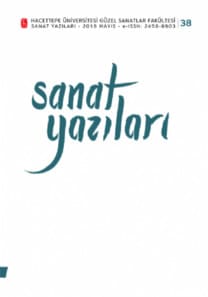BARTÓK VİYOLA KONÇERTOSU'NDA ÖZGÜNLÜK ARAYIŞLARI
Hayatının son günlerinde Béla Bartók iki eserini bitirmeye çalışıyordu: Eşi için yazdığı 3. Piyano Konçertosu ve William Primrose tarafından ısmarlanmış olan Viyola Konçertosu. Ne yazık ki hayata gözleri kapandığında Viyola Konçertosu sadece 13 sayfadan oluşmuş bir taslak halindeydi ve eseri onun yerine kendisi de bir besteci olan dostu ve öğrencisi Tibor Serly tamamladı. Bu nedenle profesyonel viyola repertuarının en çok beğenilen eserlerinden biri olmasına karşın, konçertonun özgünlüğü Bartók otoritelerince sorgulanmaktadır. 1995 yılında konçerto, Bartók'un oğlu Peter Bartók ve Nelson Dellamaggiore tarafından düzenlenip tekrar yayınlanmıştır. Bu çalışmada Bartók Viyola Konçertosu'nun yaratı süreci hakkında detaylı bilgi verilmiş, farklı viyola yorumcularının revize çalışmaları açıklanmıştır. Bununla birlikte mevcut basımlar arasındaki farklar irdelenmiş, Bartók'a özgü olması için yapılan çalışmaların esere performans yönünden katkısı tartışılmıştır. Bir icracının, yorumlayacağı eseri tanıdığında daha başarılı bir performans sergileyeceği gerçeğinden yola çıkılarak, bu çalışmanın yorumcu, akademisyen ve öğrenciler için dilimize kazandırılmış bir kaynak olması hedeflenmiştir.
for his wife and a Viola Concerto commissioned by William Primrose. Unfortunately, when he
In his last days, Béla Bartók was composing two major works: a Piano Concerto for his wife and a Viola Concerto commissioned by William Primrose. Unfortunately, when he passed away, the Viola Concerto was just in a state of a rough sketch, consisting 13 pages, and instead of him, composer Tibor Serly, a close friend, and his student completed the work. Although it is one of the most popular works in the professional viola repertoire, this concerto is often criticized by Bartók scholars for not having completed by Bartók. In 1995, this concerto was revised and published by his son Peter Bartók and Nelson Dellamaggiore. In this article, detailed information is given about the construction and the scheme of the viola concerto and revisions by various viola soloists are explained. Furthermore, some of the differences between current published editions are observed and performance issues of more authentic Bartók editions are discussed. For a performer, one of the ways to achieve a successful performance is having an insight for the subject matter piece. Inspired by that fact, this work aims to provide a Turkish source for violists, viola educators and students.
___
Asbell, Stephanie. (2001). Béla Bartók's Viola Concerto: A Detailed Analysis and Discussion of Published editions. (Yayımlanmamış Doktora Tezi). University of Texas, Austin. Erişim: 08.2015, https://www.lib.utexas.edu/etd/d/2001/asbellsa20639/asbellsa20639.pdfBaker, Theodore., rev.by Kuhn, Laura. (1995). Pocket Manual of Musical Terms. New York: Shirmer Trade Books
Bartók, Béla. (1949). Concerto for Viola and Orchestra, Reduction for Viola and Piano. Pre- pared for publication by Tibor Serly. New York: Boosey& Hawkes.
Bartók, Peter. (1993-94). The Principal Theme of Béla Bartók's Viola Concerto. Akadémiai
Kiadó. 45-50. Erişim: 14.03.2010, http://www.jstor.org/stable/902196
Bartók, Peter. (1996). Commentary on the Revised edition of Béla Bartók's Viola Concerto. Journal of the American Viola Society.11-32
Bruderer, Conrad. (1994). An Analysis of Bartók's Concerto for Viola and Orchestra, Move- ment Two. Journal of the American Viola Society, 10, (1), s. 11-21.
Cangal, Nurhan. (2011). Müzik Formları. Ankara: Arkadaş Yayınevi.
Carner, Mosco. (1950). Bartók 's Viola Concerto. The Musical Times, Vol. 91, s. (No. 1290) 303, Erişim: 23.12.2012, http://www.jstor.org/stable/10036856
Crabtree, Phillip, Foster,Donald. (1993). Sourcebook for Research in Music. Bloomington, IN: Indiana University Press.
Dalton, Donald. (1976). The Genesis of Bartók's Viola Concerto. Music & Letters, Vol. 57 (No. 2), s. 117-129. Erişim: 19.03.2010, http://www.jstor.org/stable/734979
Gillies, Malcolm. (1998). Review. Tempo, New Series, (No.205), s.33-34. Erişim: 14.08.2015, http://www.jstor.org/stable/944767
Kovács, Sandor. (1981). Reexamining the Bartók/Serly Viola Concerto. Studia Musicologia Academiae Scientiarum Hungaricae, 23, s. 295-322. Erişim: 19.03.2010, http://www.jstor. org/stable/902115
Maurice. Donald, trans. (1998). Panel Discussion: The Bartók Viola Concerto. (from the International Viola Conference in Austin, Texas). Journal of the American Viola So- ciety, 14, 1, s. 15-49. Erişim: 12.8.15, http://www.americanviolasociety.org/Journal/Arc- hives-Free.php
Maurice, Donald. (2004). Bartok's Viola Concerto: The Remarkable Story of His Swansong. New York: Oxford University Press.
Naxos Müzik Kütüphanesi. Erişim: 14.09.2015, http://www.hacettepe.naxosmusiclibrary. com/catalogue/item.asp?cid=PC10215
Saygun, Adnan. (1951). Bartok in Turkey. The Musical Quarterly, 37, 1, 5-9.
Erişim 28.08.2015, http://www.jstor.org/stable/740104
Youtube. Erişim: 20.8.2015 https://www.youtube.com/watch?v=kT3GQ-zo93s
Whittal, Arnold. (1996). At Source: How Accurately does Tibor Serly's edition of Bartók's unfinished Viola Concerto reflect the surviving sketch Material?. The Musical Times, Vol , (No. 1836), s.10-12. Erişim: 23.12.2012, http://www.jstor.org/stable/10036856
- ISSN: 2458-8903
- Yayın Aralığı: Yılda 2 Sayı
- Başlangıç: 2001
- Yayıncı: -
Sayıdaki Diğer Makaleler
WITTGENSTEIN ÇEKİMİNDE SANAT VE DİL
DEĞİŞEN SERGİ MODELLERiNDEN BİR KESİT
SUPERMAN ÇİZGİ ROMANLARINDA TARİH İÇERİSİNDE TASARIM UNSURLARININ DEĞİŞİMİ
ŞİŞKİN ANLATILARIN PANZEHİRİ: RİNEKE DİJKSTRA
BARTÓK VİYOLA KONÇERTOSU'NDA ÖZGÜNLÜK ARAYIŞLARI
LESTER D.LONGMAN PERSPEKTiFiNDEN, NEO-AVANGARD KONFORMiZM VE EĞLENCE
GÖRSEL SANAT ALANINDA SANAT YAPITI- MİMARİ MEKÂN BİRLİKTELİĞİ ÜZERİNE
